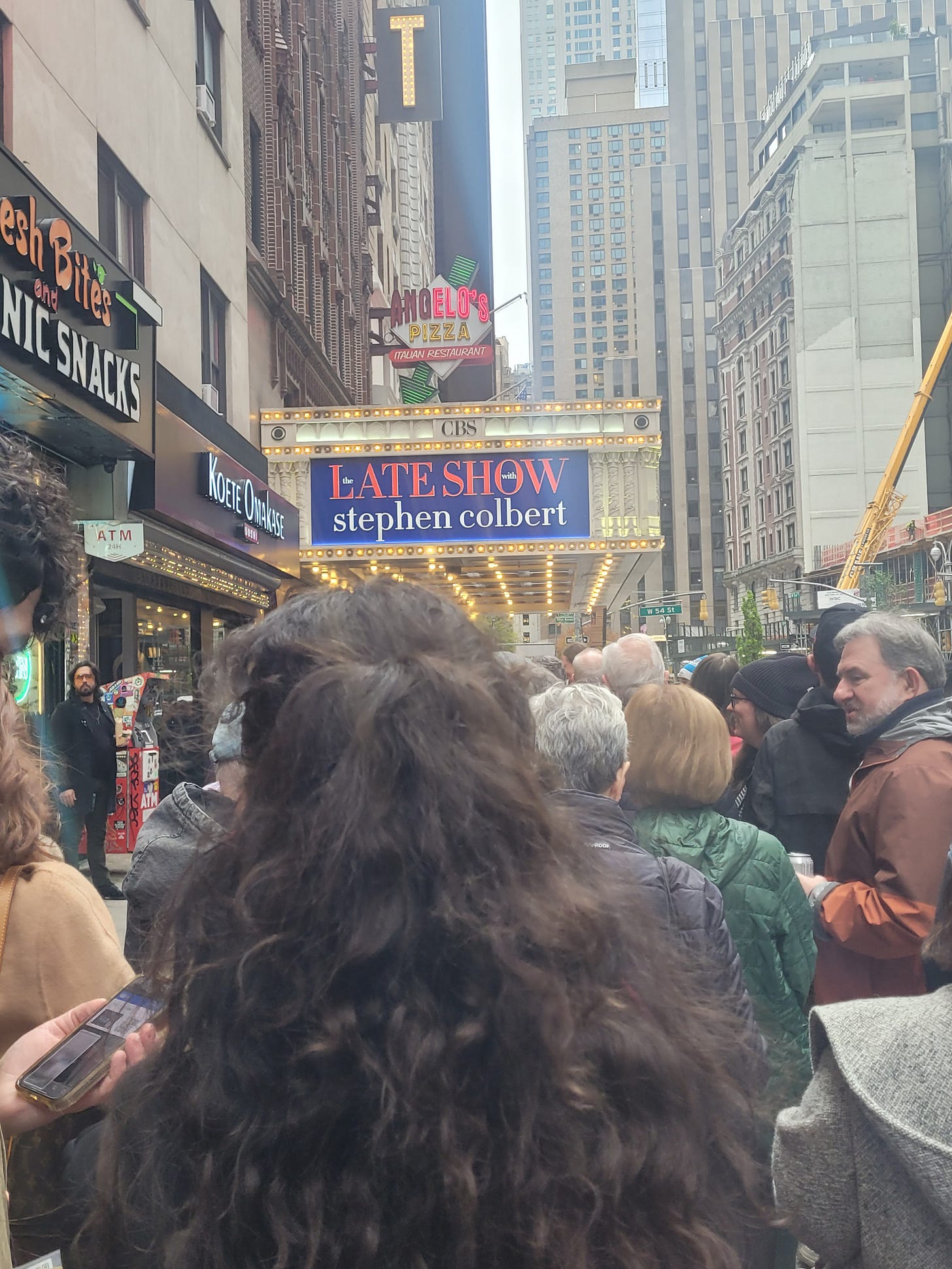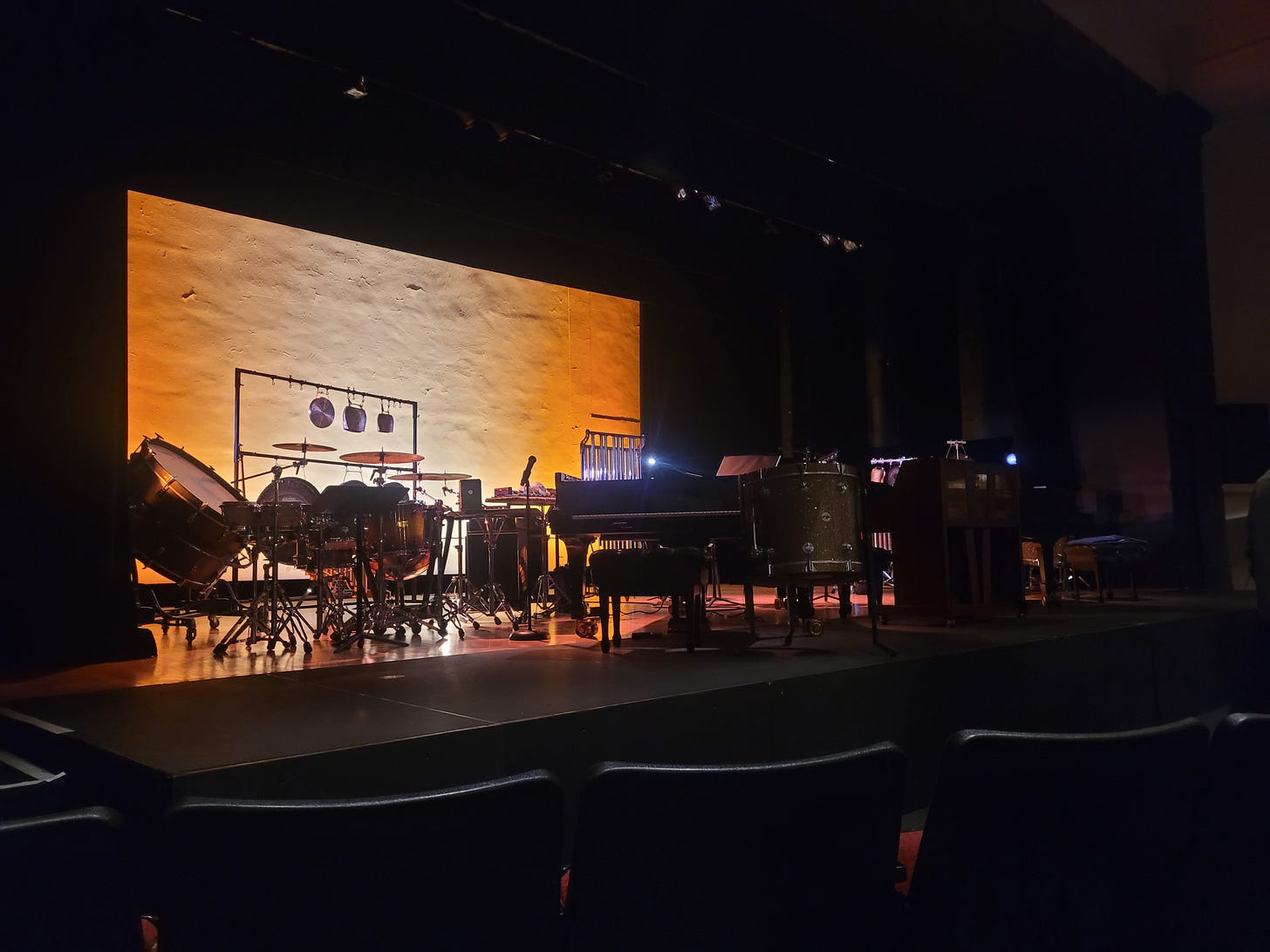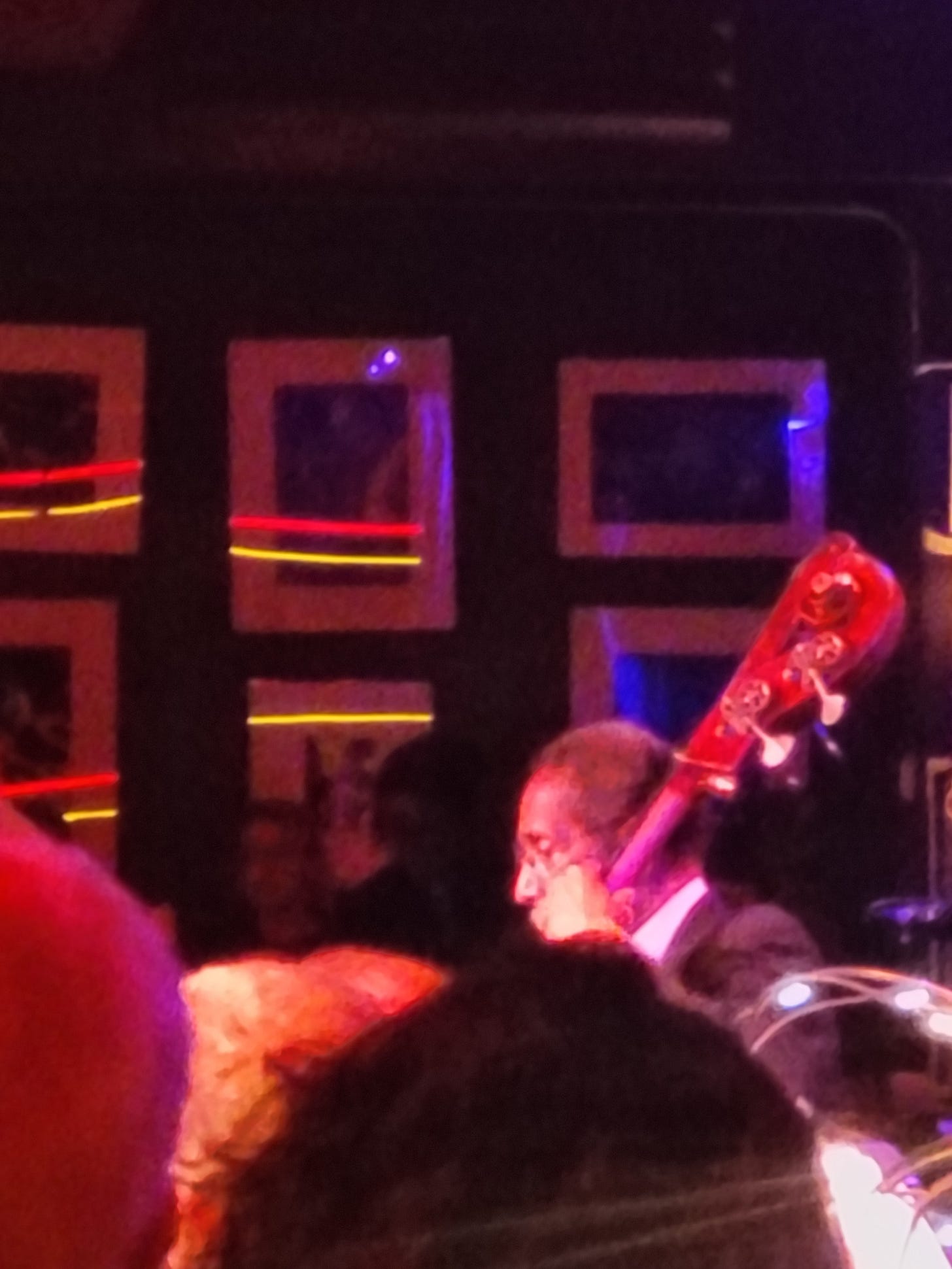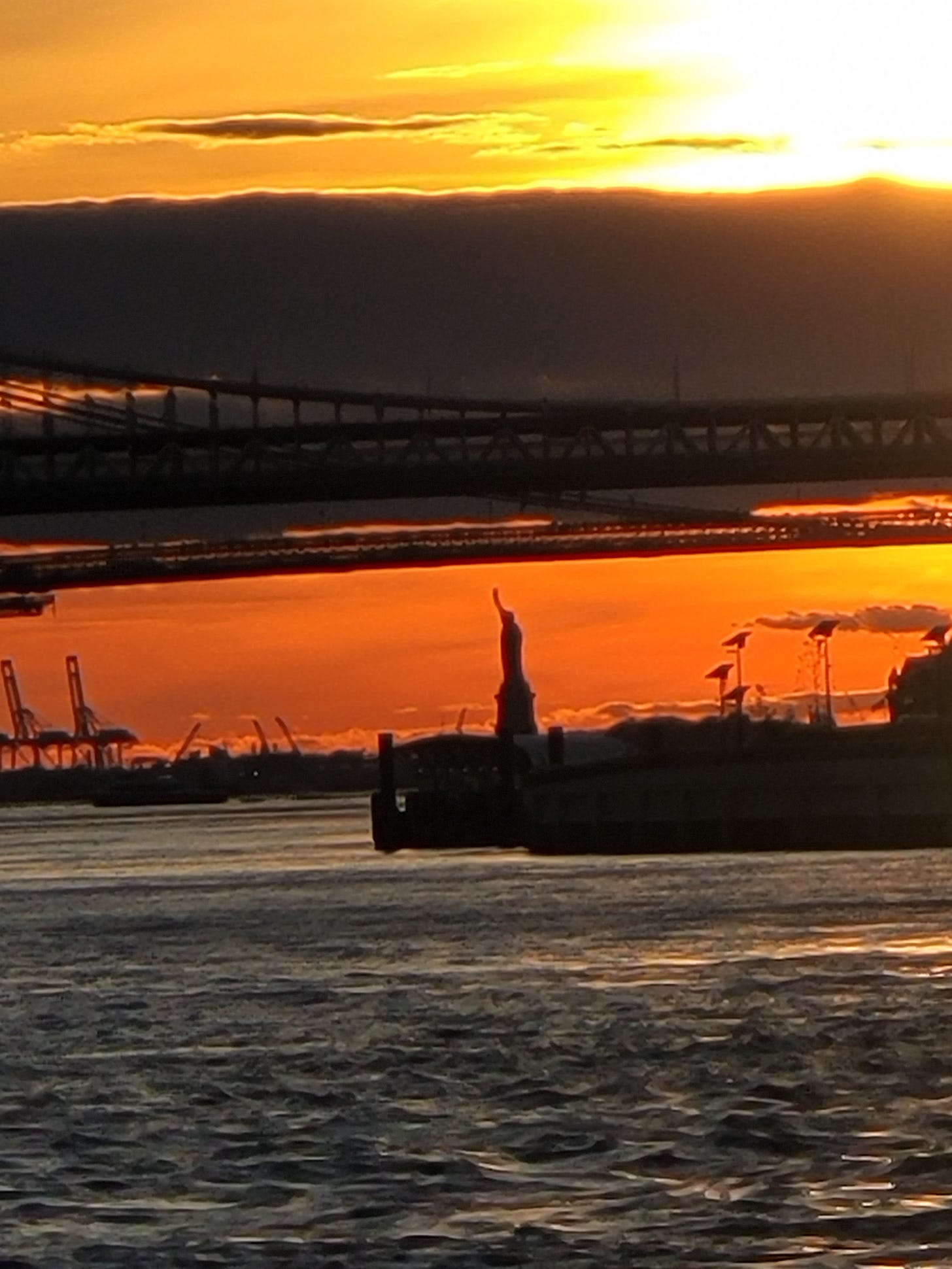Ten Days in New York
Music adventures in the city that never sleeps
As mentioned in my last dispatch, I took a solo trip to New York. It’s become an annual tradition for me and each sojourn to the city involves music in one way or another.
Last year, I wrote up about my music adventures in New York and really enjoyed doing so. So, below, is my travelogue of this year’s escapades. I hope you enjoy it and that you’ll also share some of your memorable music moments in New York.
Until next time, may good listening be with you all!
What should the sleep-deprived music lover do the first night he is back in New York? Retreat to his very modest accommodations to make up for two rather poor slumbers in a row or go out to hear some music? Shall I add the night in question was a Saturday?
No explanation needed then that there I was lined up at Smalls at around 8 p.m. to hear alto saxophonist Sarah Hanahan. I had seen her once before: in November 2023 at Smoke Jazz Club. At one point, she had us all singing part of Gary Bartz’s ‘The Song of Loving / Kindness.’ Her debut album, Among Giants, out last year, gave a taste of her lineage to both Jackie McLean and spiritual jazz, and she was part of the monster ensemble powering Joe Farnsworth’s The Big Room, one of the best albums I’ve heard this year.
She is a truly gifted player. I suspect many of the 60 or so in the club weren’t exactly sure what they were in for other than a Saturday night of jazz in New York but after the out-of-tempo eruption that began the set with Hanahan pushing her horn to the absolute breaking point, I suspect everyone then knew they were in the right place. The resolution into tempo was an urgent modal line, ‘Crash Out,’ newly composed by Hanahan that led to extended solos by each member of her quartet.
Please support my work in spreading the joy of listening to music? Become a paid subscriber of Listening Sessions for just $6/month or $50/year.
Pianist Caelan Cardello’s Tyner-like runs perched him as well as bassist Charlie Lincoln and drummer Sam “Boom-Boom” Bolduc on the tightrope. As Cardello’s improvisation continued, I wondered if how I felt: exalted, transformed, unable to keep my right foot, right hand and head from moving in time with the playing, is how it would have felt to be at Slugs’ Saloon in 1966 during the music played by Joe Henderson and group that was released last year as Forces of Nature.
Hanahan is a player who mines the past to both honour it and to find something new and personal in it. As Lincoln played an unaccompanied solo, her eyes closed with a blissful glow illuminating her face, Hanahan offered a running commentary to what he was playing. At one point, she encouraged him to keep “walking that dog.” Her ecstasy and the audience’s ecstasy slowly merged to become one and the same. It continued to mesh through Bolduc’s rumbling solo and once joined together, remained so through the rest of the set which included ‘On the Trail,’ adapted from Ferde Grofe’s Grand Canyon Suite and which Hanahan recorded on her debut, and ‘Misty.’
Both cycled through moments of calm, humour—Hanahan has a habit of beginning solos with a tossed-off note or two—rising intensity and climax after climax after climax. At the end of the set, the audience gave her a well-deserved standing ovation.
That kind of reaction is not so much earned as required if one finds oneself in the audience of one of the city’s many talk shows. That’s not to say audience members are being coerced to offer laurels against their will. They are planted in their seats because they want to be there. Two years ago, when I took in a taping of Late Night With Seth Meyers, I almost lost my mind when Meyers appeared just before taping began to talk to us for a moment. I did just about the same at the Ed Sullivan Theatre when out came Stephen Colbert. All the whooping and hollering and chanting of “Stephen” made it seem like it was he who was the front-runner for the next Mayor of New York.
Cameron Crowe was among the guests, there to promote his memoir, The Uncool, and during Colbert’s brief chat with him, bands and artists were name-dropped. Led Zeppelin. The Allman Brothers Band. Bob Dylan. Pete Townsend. At each, the crowd clapped. When Colbert shared a picture of 15-year-old Crowe interviewing Kris Kristofferson, his first as an aspiring music journalist, I began to applaud and then caught myself when no one else joined in. Fandom, I guess, is a funny thing.
The chat ended with Crowe talking about his ongoing work to get a script together for a biopic of Joni Mitchell, a project that has him in deep collaboration with her. Parts of his continuing conversation with Mitchell have guided listeners through the first four volumes of her absorbing Archives series—here’s hoping a fifth volume comes next year.
Crowe then got to the reason why he brought up Mitchell. He produced a small piece of paper and gave it to Colbert. He shared what the message said: “As a proud Stephen Colbert fan, I appreciate how you always stand your ground.” Colbert wasn’t quite sure what to do. Once the segment was in the bag and Crowe exited stage right, Colbert got up and threw his body back, taking a deep breath, processing the meaning of what just transpired and then getting back to the business at hand. There was the rest of the show to get in the can.
That sudden shift from one’s private to public persona is part of what makes live jazz in a small club so fascinating. It was present as I caught the first set of the last night at Smoke Jazz Club featuring the long-standing partnership of guitarist Peter Bernstein, organist Larry Goldings and drummer Bill Stewart. The quiet deliberation between the three as they decided what next to play out of their book. Laughter as Goldings, who acted as emcee and spokesmen for the three, riffed on the composer of the set opener, ‘Sweet and Lovely,’ Gus Arnheim (credited with Charles N. Daniels, and Harry Tobias), wondering if he wrote anything else of note (he did, ‘I Cried for You’), and also let it slip that the three had just been in the studio to record a new album coming at some point in the future and to be available definitely on LP, uncertainly on CD and specially in Corinthian leather. If only Ricardo Montalban was still alive to savour such news.
They previewed the new album with a soulful, motive-laden cover of Abdullah Ibrahim’s ‘Mamma’ and throughout the rest of the seven-song set, engaged in the easy simpatico that marks any group of jazz players who dedicate themselves to making music together.
My focus throughout was on Stewart, partly because I was seated with Goldings’ back to me which meant that Bernstein, at the front of the stage, was heard but only seen fleetingly, mostly as he used a handkerchief to mop sweat off his brow. Stewart is the kind of drummer whose entire body is channeling rhythm when he is playing. He frequently pitched forward to play a fill or bash the crash cymbal. He would also slightly lift off his stool as his feet dialogued on the hi-hat and bass drum. That kind of physical engagement in the music meant that the hi-hat stand kept moving an inch or two away from him and so Stewart continually used his left foot to move it back. That furtive adjustment—at another moment, he searched to find one of his brushes—never slowed the music’s momentum but was indicative of the added dimension when music is experienced both aurally and visually.
It did as well at Miller Theatre at Columbia University for the third and final recital toasting 20 years of Yarn/Wire, a two-pianist, two-percussionist ensemble currently comprised of founding members Laura Barger and Russell Greenberg as well as newer members Julia Den Boer and Sae Hashimoto. The program that night was centred around Tyshawn Sorey’s For Rose Gay, composed by the percussionist and Pulitzer-honoured composer with the ensemble. The work was performed in almost complete darkness. Its style could be described as modern or avant-garde with tones and then phrases traded between Sorey on celeste and the four members of Yarn/Wire.
Trying to detect an arc in a work such as this can be challenging if heard on record. In the dimmest of light, Barger and Den Boer could be seen striking a piano string with a mallet, for one instance, making it easier to appreciate how For Rose Gay slowly evolved to two furious climaxes, the first with Greenberg playing the chimes as if a church’s change ringers had suddenly gone berserk and the concluding one with both Greenberg and Hashimoto sweeping the theatre up in the din of the whoosh of cymbals that took at least a minute to decay before the audience erupted in applause. Attending a concert like that when one just happens to be in New York is glorious happenstance. Being able to catch John Cale at Lincoln Center on my second Sunday in town was another example. He, of course, is a vital link to the odd, weird New York and indeed, during the concert, there was a montage of images of those halcyon days of Andy Warhol and Lou Reed and Nico and Edie Sedgwick and Sterling Morrison that still linger in the city.
Even so, tension was never far away at David Geffen Hall that night. Cale’s appearance was part of Unsound New York, a festival of music well outside the mainstream. Prior to him taking the stage, there was an hour-long set by electronic musician Heinali and vocalist Andriana-Yaroslava Saienko. Over drones and modular sounds that often struck me similar to Terry Riley, whom Cale collaborated with for Church of Anthrax, Heinali and Saienko explored the compositions of composer Hildegard von Bargen. Through modern electronics meant to evoke the conflict in the Ukraine and singing in that country’s traditional style, their recital was stark and confrontational, especially the sustained swell of mechanized sound that drenched the hall during the first two works performed. I found it hypnotic and very, very interesting. It was at point that attendees began to leave. Not many but enough to take notice. I suspect some returned once Cale’s set began but even then, the walk-outs were a silent component to his performance.
For the opener, ‘Shark Shark,’ the only time Cale played guitar during the show, it took a minute or so for his mic to be turned up enough to actually hear him sing. ‘Captain Hook’ followed with Cale more or less planted at a keyboard for the rest of the night. It was the first of many features for a gospel choir. Again, it took a while to actually hear them. A tech issue put a quick stop to ‘Broken Bird.’ At another moment, Cale ambled over to the New York Philharmonic’s organ, tinkled with it for a moment before swerving off the bench to go back to the keyboard. After ‘Big White Cloud,’ from his 1970 debut Vintage Violence, a lanky, Burt Bacharach-looking fellow stood up to applaud. At another moment, someone shouted, “we love you John” as another small group of concert-users headed for the exits. It was that kind of night.
After 75 minutes, the unease of seeing a countercultural icon struggling to connect turned into something more magical. ‘Company Commander’ marched with the precision of a repeated refrain by the choir and ‘My Maria’ had they and Cale in lockstep to capture a radical kind of glory. For those still around, I hope they felt as I did: defiant, not done just yet with being out of step. Artists like John Cale remain indomitable because they refuse to conform, walk-outs be damned.
That explained why Mezzrow in the Village was quieter than usual for a Friday. It was Halloween. The bar attendant was dressed in a skeleton suit. A guy opposite me came as Ace Ventura. Pianist Luke Carlos O’Reilly was all in black save for a red tie. He donned sunglasses, his attempt, as he explained to us, to dress as Morpheus from The Matrix. Just outside of the club was the Annual Village Halloween Parade. That’s why Sam “Boom-Boom” Bolduc was missing in action for the start of O’Reilly’s first set at 9 p.m. No matter, Ari Hoening, in a Chinese mandarin-collar outfit, stepped in. With Adi Meyerson on bass, the make-shift trio vibrantly tackled Charles Famborough’s ‘Little Man’ and then the Beatles’ ‘Norwegian Wood (This Bird Has Flown).’
O’Reilly played economically. With teeth gritted and eyes closed, he often scatted along with his solos. Hoening was even more demonstrative, swaying in all directions as if spellbound, keeping the rhythm and time loose. Bolduc, who arrived during the fantasia of ‘Norwegian Wood,’ played more deliberatively than he did at Smalls six nights earlier with Hanahan.
With him also came vocalist Emily Braden. She sang soulfully, her voice curving and gliding along a song’s melody. She belted out a blues like ‘Evil Gal Blues,’ caressed a soul number like Aretha Franklin’s ‘Land of Dreams’ and inspired a shiver of delight when she sang the opening line of ‘Everybody Wants to Rule the World.’ As the set wrapped, O’Reilly invited all to stick around for the next set. I was the only to take him up on the offer.
The second set began with O’Reilly, Meyerson and Bolduc playing a sparkling version of Vince Guaraldi’s ‘The Great Pumpkin Waltz’ and following with the gospel flavour of a Jody DeFrancesco piece that reminded of Oscar Peterson’s ‘Hymn to Freedom.’ Braden returned for four enchanting numbers of loose, flowing singing. A tribute to D’Angelo, ‘Spanish Joint,’ morphed into Michael Jackson’s ‘Want to Be Startin’ Somethin’’ and in another ode to October 31, ‘I Put a Spell on You’ turned into ‘Come Rain or Come Shine.’ It was a Halloween spent well.
The night before, the scene was Birdland for the opening set by Ron Carter and his Big Band, part of the great bassist’s month-long residency at the club—at Birdland, it wasn’t October but Ron-tober. Seated at the bar, I edged my way into a conversation with a couple from Wilmington, Delaware, in New York for the first time in three years, after the husband mentioned to the bartender—an affable fellow too—that he had seen Count Basie live just before he passed with Freddie Green still strumming the Basie beat in the guitar chair. We reveled in how wonderful it was that Carter was still playing and as evidenced by a solo version of ‘You Are My Sunshine,’ continuing to play the bass as well as just about anyone who has taken up the instrument. At another point, Carter slipped in a quote of ‘Santa Claus is Coming to Town.’ I squealed in delight.
The band was tight. An arrangement of Sonny Stitt’s ‘The Eternal Triangle’ broke down the harmonic structure as Miles Davis may have if he had recorded it while Carter was holding down the bottom in his band. As the bassist walked from the bandstand to pass by the bar, I clapped. He briefly waved in my direction.
You can find music everywhere in New York. At Washington Square, I stumbled upon a guy playing an upright piano that in a style that was half-cabaret, half-Ray Charles. He sang with warmth like James Taylor. I came upon him just as he started the Beatles’ ‘Martha My Dear.’ He followed with a long blues. After chorus upon chorus of improvisation, he slowed down and then launched into the middle movement of Beethoven’s Moonlight Sonata as if it was the most natural thing in the world to do. There was a quintet playing Benny Golson’s ‘Are You Real?’ at Grand Central. On a 1 train from 79th Street to Times Square, two hustlers scrounged for scraps of dough by serenading the strap-hangers to the Commodore’s ‘Easy.’
There aren’t necessarily moments that are particularly special except that they took place amid the hubbub of New York. To put it another way, a park may be just a park but a park like Domino Park in Williamsburg where Manhattan from its southern tip to 59th Street is offered in one grant panorama is something else entirely. I offer these observations if only to explain why, for me, departing New York doesn’t mean wondering if I will return, only when. To that, the response remains, as always, as soon as humanly possible.








Sounds like you had some great listening. I bet many of your younger readers might not get the Corinthian leather reference. However, instead of wondering about it they would probably type it into the search bar.